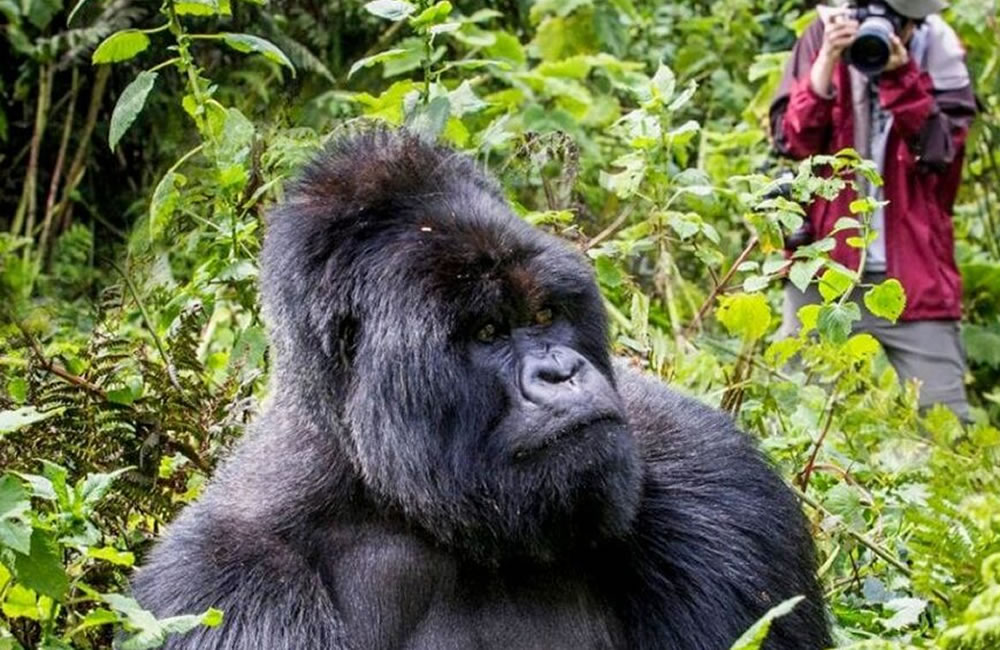Around only 1000 mountain gorilla still exist today. Although our closest living relatives, ironically, it is man that poses the greatest threat to their survival. For years gorillas have been ruthlessly hunted for their hands and heads, which are sold on as macabre souvenir ashtrays and lamp shades. Additionally, large numbers have been killed whilst trying to stop poachers stealing babies which are illegally sold on to zoos, where their survival rate is low. This has affected gorilla conservation in Africa.
Gorilla trekking is a wonderful experience, allowing you the opportunity to have a close encounter with these gentle giants of the jungle in their natural habitat. The trekking will take place either in Uganda, Rwanda or Democratic Republic of Congo – depending on local conditions and the availability of the gorilla permits. You need not feel that you are exploiting these animals by paying good money to go trek to see them in their natural habitat. In fact the ever-growing number of tourists keen to see the gorilla proves to be an important factor in their survival. The gorilla permit fees help to set up and finance patrols that are instrumental in protecting the gorillas from poachers and their lethal snares.
Gorilla Permit Costs
On most African overland safaris, gorilla trekking is an optional activity and the cost of the permit, transfer and local service fee is to be paid upon arrival. We also offer a 4 day Gorilla Express lodge accommodated safari in Rwanda, please note that on this trip the cost of the gorilla permit, transfer and service fee is included.
The cost and availability of gorilla permits varies by country and park and currently ranges from USD 400 – 1500. You will also need to budget for visa fees (costs vary), transfer and a local service fee (approx USD 60 – 75) and to renew your Ugandan or East African visa upon re-entry should we have to go to Rwanda or DR Congo. The government often increases the permit and transfer costs without notice, so we ask that you budget for the highest amount, so that you don’t suddenly have to find additional money to partake in this wonderful experience. We recommend you budget a total of atleast US$ 1200.
The reason that the permits are so costly is because each park only issues 10 permits per gorilla family per day, to ensure that the gorilla’s exposure to humans is limited. 100% of the gorilla permit cost is used by the government to continue in the excellent work they do in protecting and promoting these wonderful animals.
Tours companies are not in control of the price of gorilla permits and therefore cannot be held responsible for any increase in fees. If the political situation in this region should change, there is the chance that the itinerary would be amended and an alternative scenario advised prior to departure if possible.
Trekking to see the Gorillas
The trek starts in the early morning and after border formalities you are transferred to a ranger’s station where the trek commences. Your rangers will lead you through the cultivated lands and then into the dense rain forest and as close as is allowed to a gorilla family. The rangers monitor the gorillas on a daily basis and have a fairly good idea of where they are. However, they are free roaming animals, and their sighting cannot be guaranteed. Trekking can take anywhere from 45 minutes to 8 hours and it can be quite strenuous, so a reasonable level of fitness is required.
To ensure the gorillas do not get too used to the presence of humans and because they share many of our genes (and are therefore able to catch our diseases), the maximum time permitted to spend with them is 1 hour. You will have plenty of time to watch their activity and to take photographs. The rangers will be able to provide you with a background to the family you are visiting. Once your hour is up, you trek back out of the rain forest to your meeting point. Clients considering joining this trip should realize the demands and unpredictability of the areas visited. These factors may contribute toward restricting or delaying our trip and viewing of the gorillas. Often, the trek through thick, dense jungle can be somewhat strenuous and due to the nature of the gorillas and their habits, viewing cannot be guaranteed.
IMPORTANT: Although the groups of gorilla that are sought out on our jungle trek have been habituated, they have not been tamed and their behaviour is not demonstrably different from that of non-habituated groups. Nobody forces them to stay with us for the allotted hour, and they can fade into the forest as you appear, if they wish to do so. Further, as gorillas are EXTREMELY sensitive to human disease, the park authorities will not allow anyone they consider to be in poor health to visit the gorilla groups. Additionally, no children under 16 years of age are permitted to visit.
